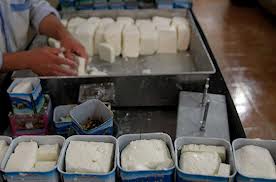Assessment of rural dairy products in North Kordofan State, Sudan-2
Keywords:
Experimental dairy products;Cows;GoatsAbstract
Laboratory cheese making trials were conducted in a ruralarea of western Sudan (North Kordofan) to study the effects of milk type (goatvs. cow) and cheese type (white soft vs. braided) on cheese characteristics.Randomized complete block design for the cheese samples data and a 2x2factorial randomized complete block design for the laboratory trials data wereused. Goat milk recorded the highest (P < 0.05) ash contents, whereas cowmilk contained the highest total solids (TS), fat, lactose and protein. Goatmilk required longer coagulation time compared with cow milk. White cheeserequired relatively (P > 0.05) more time to coagulate compared with braidedcheese. White cheese made from goat milk (WG) required the longest (P <0.05) coagulation time, followed by braided cheese from goat milk (BG), braidedcheese from cow milk (BC) and then white cheese from cow milk (WC). Cheeseyield was significantly affected by both milk and cheese types (P < 0.01)and their interaction (P < 0.05). The yield of WC was the highest, followedby WG, BC and the least was for BG. Goat cheese had the highest pH, whereas cowcheese had the highest TS, fat and protein contents. Braided cheese had thehighest pH, TS, and protein contents while fat contents were highest in whitesoft cheese. Efficiency of protein and fat recovery were highest in cow cheese(P < 0.05). The highest efficiency of recovery was found in braided cheese.No staphylococcus and Coliform bacteria were detected in milk samples used incheese making trials. BG recorded the highest scores in color (P < 0 .001),texture (P > 0.05) and flavor (P< 0.01). However, taste score was higher(P < 0.05) in BC compared to the other three cheese types. Cheese producedunder laboratory conditions in this study was of high quality. However, thereis a high need to raise the awareness of rural dairy producers on hygiene andpublic health measures necessary for obtaining safe dairy products. Milkintended for dairy processing should be heated (boiling, pasteurization) inorder to control bacterial growth and to ensure good quality dairy products.Moreover, there is also a high need for setting quality standards and measuresfor the different dairy products. Cheese making from sheep and camel milkshould also be tested. Other milk coagulants (natural and/or synthetic) shouldalso be evaluated to reduce cost.
References
Ahmed, A.M., 1985. Bacteriological and Chemical Characteristics of Sudanese White Cheese Produced and Stored
under Different Conditions, Ph.D. Theses. University of Khartoum, Sudan.
Abdel-Razig, K.A., 1996. The Production of White Soft Cheese from Different Milk Sources. M.Sc. Thesis, University
of Khartoum, Sudan.
Abdalla, O.M., Christen, G.L., Davidson, P.M., 1993. Chemical composition of and Listeria monocytogenes survival
in White pickled cheese. J. Food. Prot., 56, 841-846.
Abdalla, O.M., Abdel, R.A.K., 1997. Effect of type of milk on the quality of white soft cheese. U.K. J. Agric. Sci., 5,
-157.
Ahmed, T.K., Khalifa, N.A., 1989. The Manufacture of white soft cheese from recombined milk. Sudan J. Anim.
Prod., 2, 63-69.

Downloads
Published
How to Cite
Issue
Section
License
Copyright (c) 2014 F.M. El-Hag, M. I. Bushara, M. M. Ahamed, K.E. H. Mahmoud, M.A. M. Khair, O. E. Elbushra

This work is licensed under a Creative Commons Attribution-NonCommercial-NoDerivatives 4.0 International License.



